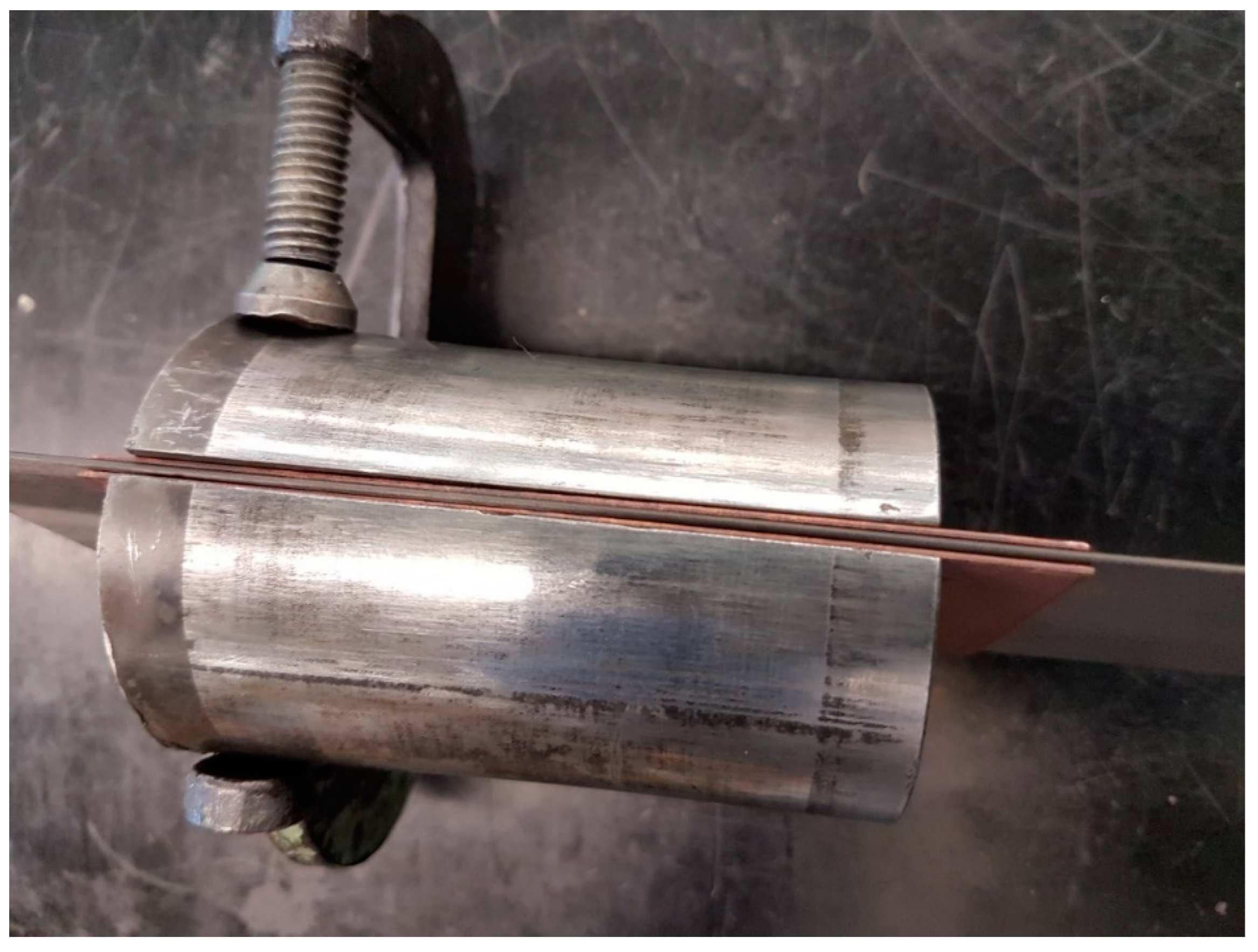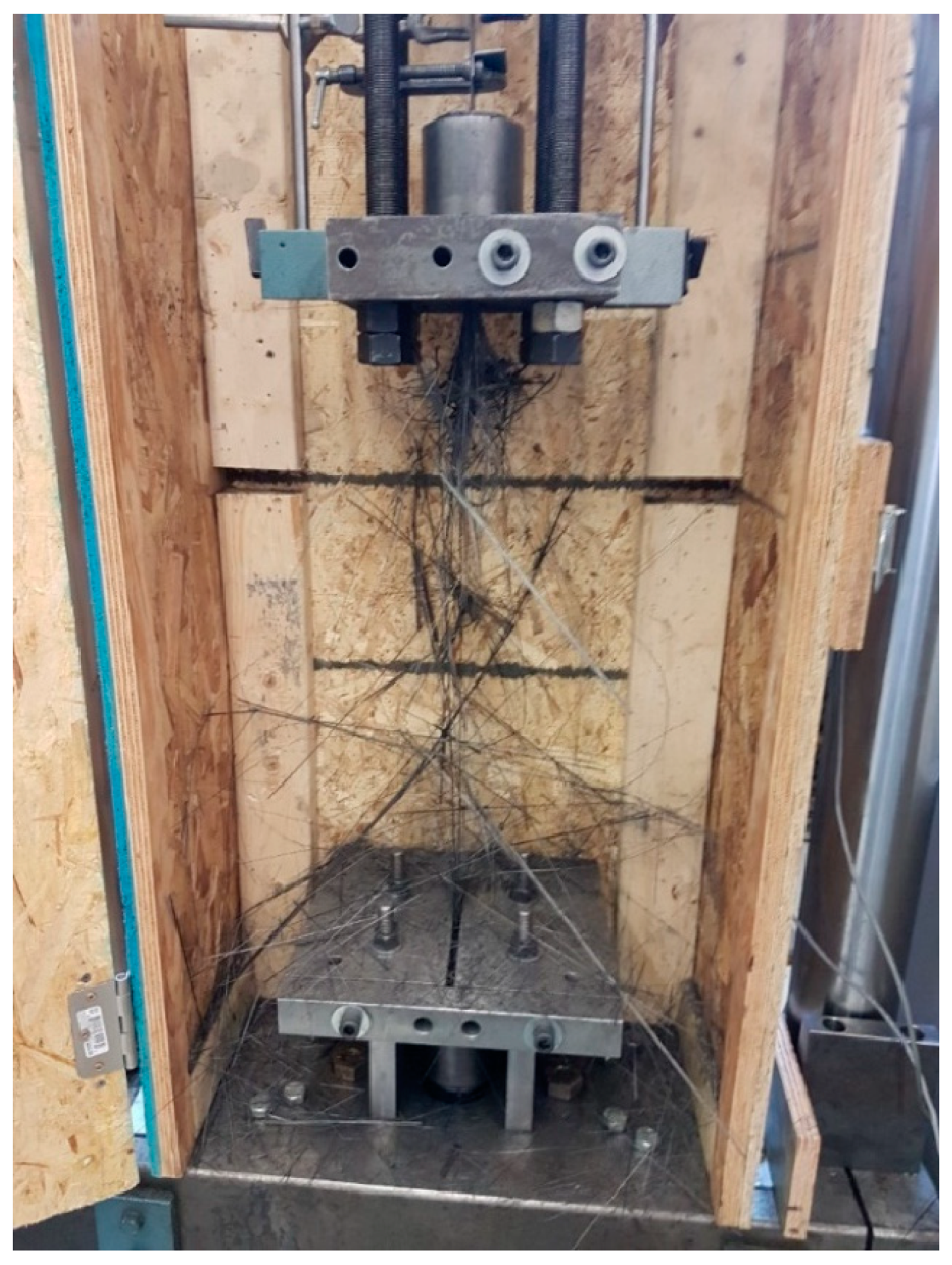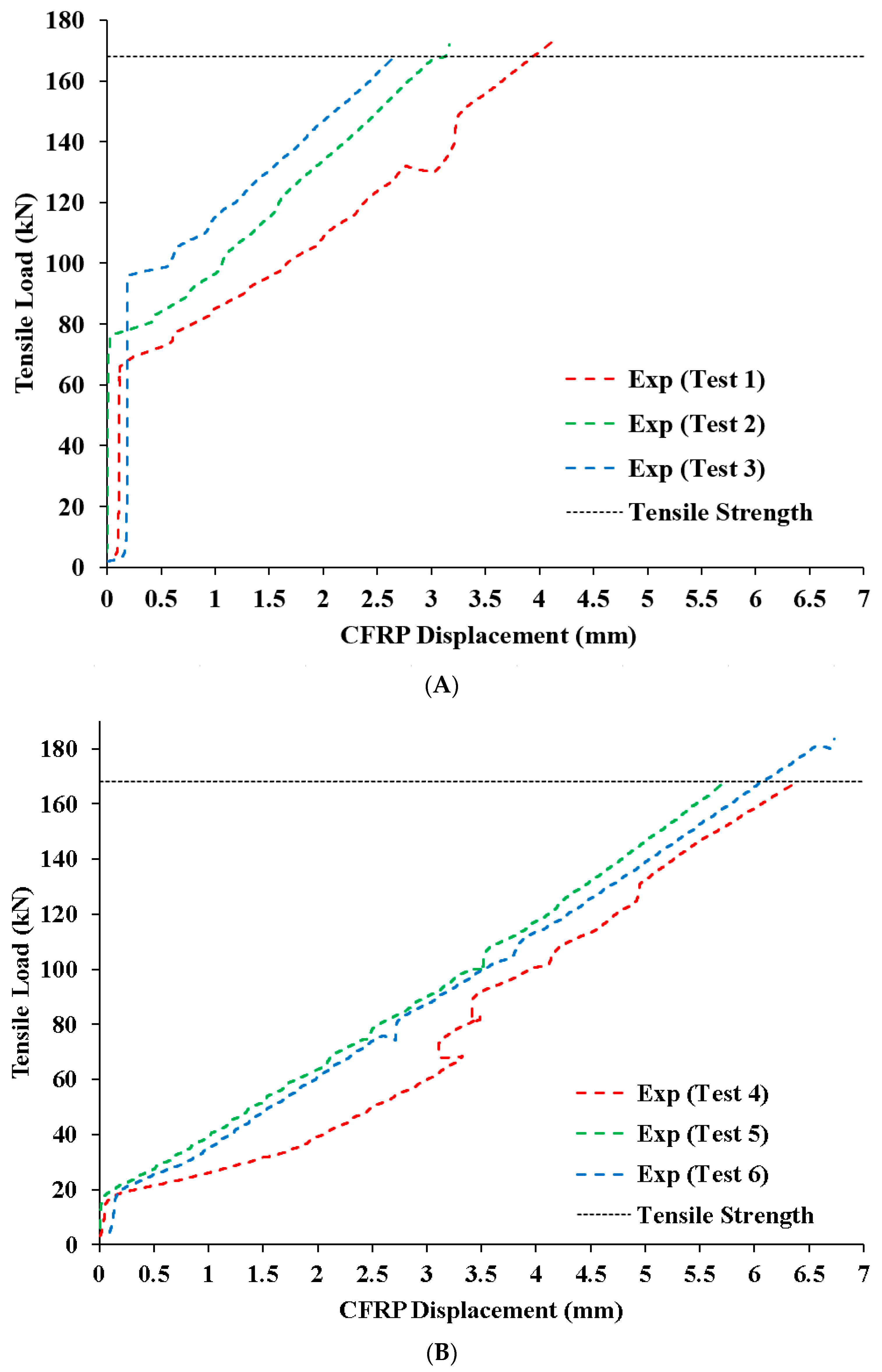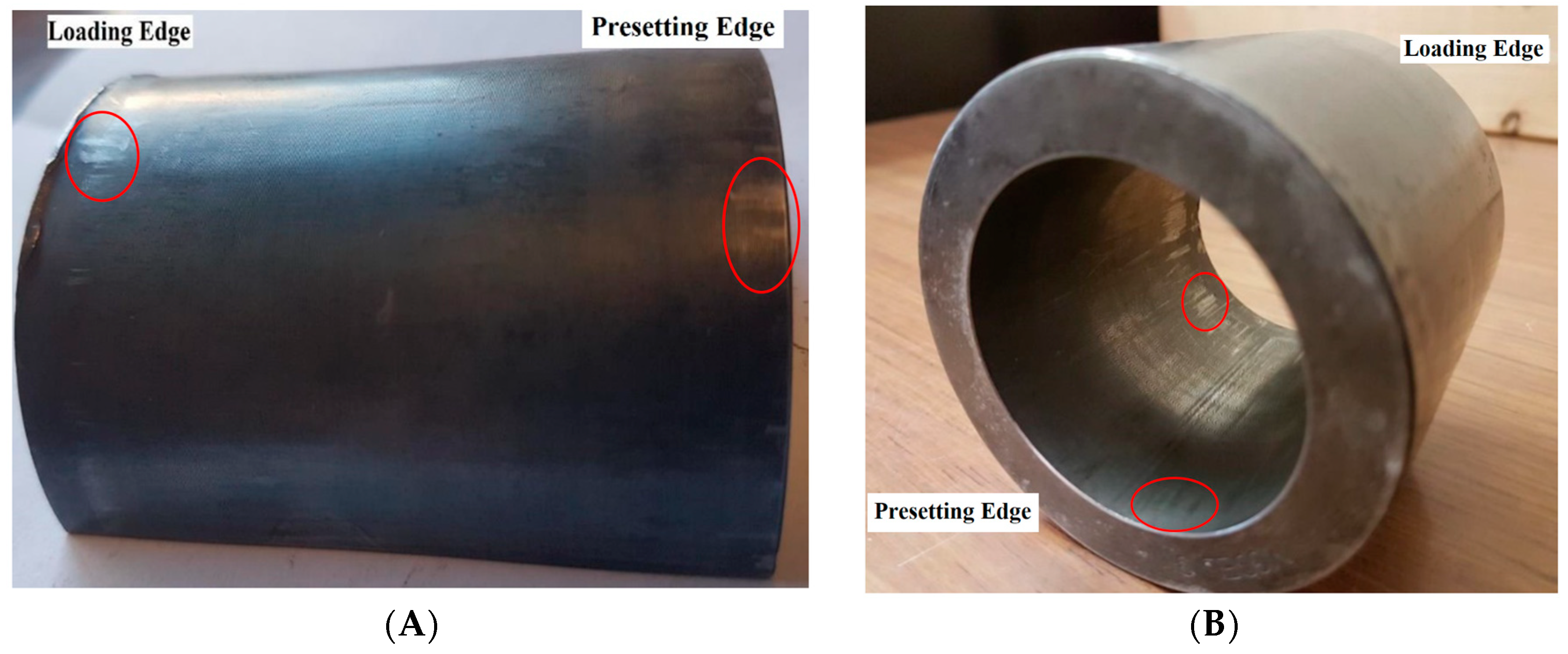Innovative Wedge Anchorage for CFRP Plates: Development and Testing
Abstract
:1. Introduction
2. Test Elements
2.1. CFRP Plate
2.2. Copper Sleeves
2.3. Wedge Anchorages
3. Test Procedures and Instrumentations
3.1. Part Assembly
3.2. Anchorage Presetting
3.3. CFRP Tensile Loading
4. Results and Discussion
4.1. General
4.2. CFRP Failure Load
4.3. CFRP Displacement
4.4. CFRP Slippage
4.5. CFRP Fracture and Anchorage Damage Analysis
5. Conclusions
- The wedge anchorage effectively gripped the CFRP plate under both high and low presetting conditions until its full reported tensile strength was reached by preventing stress concentration within the CFRP plate.
- Only minor CFRP displacement ranging from 2.65 mm to 6.35 mm was recorded, indicating that the wedge anchorage is capable of preserving CFRP prestressing.
- The CFRP plate experienced low slippage of only 0.2–2.2 mm, mitigating abrasion damage.
- Applying a higher presetting level had a minor effect on the failure load of the CFRP plate, but it substantially reduced the CFRPs’ displacement and slippage.
- Post-experimental visual inspection revealed that the anchored segment of the CFRP plate remained intact even after the full fracture of its loading end.
- The wedge anchorage maintained its excellent performance throughout the repeated tests while enduring only minor surface scratches at the loading and presetting ends of its wedges and barrel.
Author Contributions
Funding
Data Availability Statement
Conflicts of Interest
References
- Wardhana, K.; Hadipriono, F. Analysis of Recent Bridge Failures in the United States. J. Perform. Constr. Facil. 2003, 17, 144–150. [Google Scholar] [CrossRef]
- Petrović, Z.C. Catastrophes caused by corrosion. Vojnoteh. Glas. 2016, 64, 1048–1064. [Google Scholar] [CrossRef]
- ASCE Infrastructure Report Card; American Society of Civil Engineers (ASCE): Reston, VA, USA, 2017.
- Al-Mahaidi, R.; Kalfat, R. Investigation into CFRP plate end anchorage utilising uni-directional fabric wrap. Compos. Struct. 2011, 93, 821–830. [Google Scholar] [CrossRef]
- Meier, U. Carbon fiber-reinforced polymers: Modern materials in bridge engineering. Struct. Eng. Int. 1992, 2, 7–12. [Google Scholar] [CrossRef]
- Hassan, S.A.; Gholami, M.; Ismail, Y.S.; Sam, A.R.M. Characteristics of concrete/CFRP bonding system under natural tropical climate. Constr. Build. Mater. 2015, 77, 297–306. [Google Scholar] [CrossRef]
- Zheng, Y.; Zhou, Y.; Zhou, Y.; Pan, T.; Zhang, Q.; Liu, D. Cracking behavior of reinforced concrete beams strengthened with CFRP anchorage system under cyclic and monotonic loading. Eng. Struct. 2020, 207, 110222. [Google Scholar] [CrossRef]
- Al-Safy, R.; Al-Mahaidi, R.; Simon, G.P.; Habsuda, J. Experimental investigation on the thermal and mechanical properties of nanoclay-modified adhesives used for bonding CFRP to concrete substrates. Constr. Build. Mater. 2012, 28, 769–778. [Google Scholar] [CrossRef]
- Al-Rousan, R.Z. Impact of elevated temperature and anchored grooves on the shear behavior of reinforced concrete beams strengthened with CFRP composites. Case Stud. Constr. Mater. 2021, 14, e00487. [Google Scholar] [CrossRef]
- Kalfat, R.; Al-Mahaidi, R. Investigation into bond behaviour of a new CFRP anchorage system for concrete utilising a mechanically strengthened substrate. Compos. Struct. 2010, 92, 2738–2746. [Google Scholar] [CrossRef]
- Hong, S.; Park, S.-K. Concrete beams strengthened with prestressed unbonded carbon-fiber-reinforced polymer plates: An experimental study. Polym. Compos. 2017, 38, 2459–2471. [Google Scholar] [CrossRef]
- Hong, S.; Park, S.-K. Effect of prestress and transverse grooves on reinforced concrete beams prestressed with near-surface-mounted carbon fiber-reinforced polymer plates. Compos. Part B Eng. 2016, 91, 640–650. [Google Scholar] [CrossRef]
- Peng, H.; Zhang, J.; Cai, C.S.; Liu, Y. An experimental study on reinforced concrete beams strengthened with prestressed near surface mounted CFRP strips. Eng. Struct. 2014, 79, 222–233. [Google Scholar] [CrossRef]
- Peng, H.; Zhang, J.; Shang, S.; Liu, Y.; Cai, C.S. Experimental study of flexural fatigue performance of reinforced concrete beams strengthened with prestressed CFRP plates. Eng. Struct. 2016, 127, 62–72. [Google Scholar] [CrossRef]
- Benmokrane, B.; Xu, H.; Nishizaki, I. Aramid and carbon fibre-reinforced plastic prestressed ground anchors and their field applications. Can. J. Civ. Eng. 1997, 24, 968–985. [Google Scholar] [CrossRef]
- Kim, H.-J.; Sim, J. Mechanical properties of GFRP slip-form for in-situ application. KSCE J. Civ. Eng. 2016, 20, 1842–1851. [Google Scholar] [CrossRef]
- Zhao, X.-L. FRP-Strengthened Metallic Structures; CRC Press: Boca Raton, FL, USA, 2014; ISBN 978-0-203-89521-4. [Google Scholar]
- Lees, J.M.; Gruffydd-Jones, B.; Burgoyne, C.J. Expansive cement couplers: A means of pre-tensioning fibre-reinforced plastic tendons. Constr. Build. Mater. 1995, 9, 413–423. [Google Scholar] [CrossRef]
- Meier, U.; Farshad, M. Connecting high-performance carbon-fiber-reinforced polymer cables of suspension and cable-stayed bridges through the use of gradient materials. J. Comput.-Aided Mater. Des. 1996, 3, 379–384. [Google Scholar] [CrossRef]
- Taerwe, L. Non-Metallic (FRP) Reinforcement for Concrete Structures: Proceedings of the Second International RILEM Symposium; CRC Press: Boca Raton, FL, USA, 1995; ISBN 978-0-419-20540-1. [Google Scholar]
- Zhang, B.; Benmokrane, B. Design and evaluation of a new bond-type anchorage system for fiber reinforced polymer tendons. Can. J. Civ. Eng. 2004, 31, 14–26. [Google Scholar] [CrossRef]
- Puigvert, F.; Crocombe, A.D.; Gil, L. Static analysis of adhesively bonded anchorages for CFRP tendons. Constr. Build. Mater. 2014, 61, 206–215. [Google Scholar] [CrossRef]
- Schmidt, J.W.; Bennitz, A.; Taljsten, B.; Pedersen, H. Development of Mechanical Anchor for CFRP Tendons Using Integrated Sleeve. J. Compos. Constr. 2010, 14, 397–405. [Google Scholar] [CrossRef]
- Ye, H.; Liu, C.; Hou, S.; Wang, T.; Li, X. Design and experimental analysis of a novel wedge anchor for prestressed CFRP plates using pre-tensioned bolts. Compos. Struct. 2018, 206, 313–325. [Google Scholar] [CrossRef]
- Burtscher, S. Wedge Anchorage for CFRP Strips. J. Compos. Constr. 2008, 12, 446–453. [Google Scholar] [CrossRef]
- Han, Q.; Wang, L.; Xu, J. Test and numerical simulation of large angle wedge type of anchorage using transverse enhanced CFRP tendons for beam string structure. Constr. Build. Mater. 2017, 144, 225–237. [Google Scholar] [CrossRef]
- Sayed-Ahmed, E.Y.; Shrive, N.G. A new steel anchorage system for post-tensioning applications using carbon fibre reinforced plastic tendons. Can. J. Civ. Eng. 1998, 25, 113–127. [Google Scholar] [CrossRef]
- Czaderski, C.; Martinelli, E.; Michels, J.; Motavalli, M. Effect of curing conditions on strength development in an epoxy resin for structural strengthening. Compos. Part B 2011, 43, 398–410. [Google Scholar] [CrossRef]
- Akbarzadeh Bengar, H.; Shahmansouri, A.A. A new anchorage system for CFRP strips in externally strengthened RC continuous beams. J. Build. Eng. 2020, 30, 101230. [Google Scholar] [CrossRef]
- Schmidt, J.W.; Bennitz, A.; Täljsten, B.; Goltermann, P.; Pedersen, H. Mechanical anchorage of FRP tendons—A literature review. Constr. Build. Mater. 2012, 32, 110–121. [Google Scholar] [CrossRef]
- Al-Mayah, A.; Soudki, K.; Plumtree, A. Simplified Anchor System for CFRP Rods. J. Compos. Constr. 2013, 17, 584–590. [Google Scholar] [CrossRef]
- Li, X.; Deng, J.; Wang, Y.; Xie, Y.; Liu, T.; Rashid, K. RC beams strengthened by prestressed CFRP plate subjected to sustained loading and continuous wetting condition: Time-dependent prestress loss. Constr. Build. Mater. 2021, 275, 122187. [Google Scholar] [CrossRef]
- Feng, P.; Zhang, P.; Meng, X.; Ye, L. Mechanical Analysis of Stress Distribution in a Carbon Fiber-Reinforced Polymer Rod Bonding Anchor. Polymers 2014, 6, 1129–1143. [Google Scholar] [CrossRef]
- Al-Mayah, A.; Soudki, K.; Plumtree, A. Effect of sleeve material on interfacial contact behavior of CFRP-metal couples. J. Mater. Civ. Eng. 2006, 18, 825–830. [Google Scholar] [CrossRef]
- Alhusain, M. Development, Optimization and Testing of an Innovative Wedge Anchorage for CFRP Plates. Master’s Thesis, University of Waterloo, Waterloo, ON, Canada, 2018. [Google Scholar]
- American Iron and Steel Institute. Design Guidelines for the Selection and Use of Stainless Steel; American Iron and Steel Institute: Washington, DC, USA, 1993. [Google Scholar]
- Shaji, S.; Radhakrishnan, V. An investigation on solid lubricant moulded grinding wheels. Int. J. Mach. Tools Manuf. 2003, 43, 965–972. [Google Scholar] [CrossRef]
- Alhusain, M.; Al-Mayah, A. Novel Wedge Anchorage for CFRP Plates. In Proceedings of the 10th International Conference on FRP Composites in Civil Engineering, İstanbul, Turkey, 8–10 December 2021; Ilki, A., Ispir, M., Inci, P., Eds.; Springer International Publishing: Cham, Switzerland, 2022; pp. 2197–2208. [Google Scholar]
- Al-Mayah, A.; Soudki, K.; Plumtree, A. Experimental and analytical investigation of a stainless steel anchorage for CFRP prestressing tendons. PCI J. 2001, 46, 88–99. [Google Scholar] [CrossRef]













Disclaimer/Publisher’s Note: The statements, opinions and data contained in all publications are solely those of the individual author(s) and contributor(s) and not of MDPI and/or the editor(s). MDPI and/or the editor(s) disclaim responsibility for any injury to people or property resulting from any ideas, methods, instructions or products referred to in the content. |
© 2024 by the authors. Licensee MDPI, Basel, Switzerland. This article is an open access article distributed under the terms and conditions of the Creative Commons Attribution (CC BY) license (https://creativecommons.org/licenses/by/4.0/).
Share and Cite
Alhusain, M.; Al-Mayah, A. Innovative Wedge Anchorage for CFRP Plates: Development and Testing. J. Compos. Sci. 2024, 8, 103. https://doi.org/10.3390/jcs8030103
Alhusain M, Al-Mayah A. Innovative Wedge Anchorage for CFRP Plates: Development and Testing. Journal of Composites Science. 2024; 8(3):103. https://doi.org/10.3390/jcs8030103
Chicago/Turabian StyleAlhusain, Mustafa, and Adil Al-Mayah. 2024. "Innovative Wedge Anchorage for CFRP Plates: Development and Testing" Journal of Composites Science 8, no. 3: 103. https://doi.org/10.3390/jcs8030103





